Content marketing generates traffic, leads, and sales.
Anyone, anywhere can take advantage of it.
But there’s a problem:
‘Good’ content isn’t good enough anymore.
Not when there are millions of blog posts published daily and shared via social media. Not when only the top three positions on any given SERP see all the results. Not when the bar to create great content keeps rising exponentially, taking longer and longer and longer to come up with stuff that gets results.
What does all that mean?
It means average isn’t good enough. It means only the excellent stuff breaks through the noise, getting ranked, clicked, or shared on social media. And it means your options for scaling KPI-generating blog content are getting smaller and smaller.
Freelance writers don’t always work well…
… and neither do website content writing services, despite being one of the most popular ways to find blog writers for hire, which we’ll illustrate in this case study.
We purchased articles from five popular content writing services. We gave each of them the same writing prompt. And below, we’ll compare them not only to each other, but also the top original content currently ranking for the same keyword to show you exactly why each example falls way, way short of ever delivering an ROI for you — despite the ‘low cost.’
Ready to get started? Here goes:
➊ Executive Summary
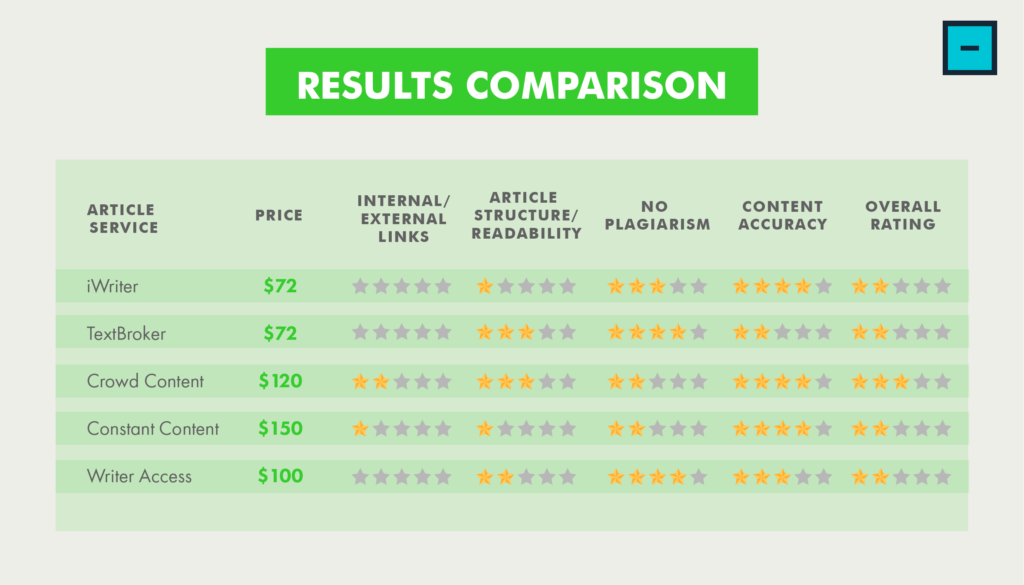
Here is the comparison of each content writing service, their cost, and their rating for each objective grading criteria. (Star values for overall ratings will be rounded.)
The short answer? Somewhere between not good and not terrible. Read on below to see how we came to this conclusion, along with feedback from over a dozen other content experts.
✅ Crowd Content came in first place with three out of five stars.
✅ Crowd Content was the only content service that got a single “Yes” from influencers when asked if they would publish on their own site. Although it was “Yes, but it would need some soft changes.”
✅ TextBroker and Writer Access had low plagiarism scores and unique article structures.
❌ Crowd Content, iWriter, and Constant Content had suspiciously similar article structures and even directly copied sections from popular content, suggesting that it was simply regurgitated rather than original, quality content.
❌ Three out of Five services (iWriter, TextBroker and Writer Access) lacked any internal or external links. Yikes!
➋ Method: How the Content Farm Olympics Work
| Section Contents: ➁.➀ How this Case Study Works ➁.➁ SERP Comparison #1. Content Marketing Institute ➁.➂ SERP Comparison #2. Neil Patel ➁.➃ SERP Result #3. Moz |
|---|
➁.➀ How this Case Study Works

So, what is the Content Farm Olympics and why should you care?
The Olympics is the testing of five major website content writing services. These services are used by thousands of other businesses online to get unique website content.
You might even be here looking for reviews and information on one of these sites based on your own content writing needs. Creating good content is crucial for driving organic traffic online.
But creating it sucks. When was the last time you sat back and enjoyed spending hours writing a post? Or spending multiple days doing keyword and topic research as well as months of content strategizing?
Psh, me neither. Heck, even professional writers don’t really get excited creating web content.
Your time management is of the essence. And unique content is very personalized: each business has a different tone, style, and audience, making the outsourcing of original content a tricky process. We have to cater to multiple diverse personas in a single post. To tap into their fears, wants, and desires.
It’s critical to find a company that can adapt fast to different verticals, audiences, and tones. Most turn to less expensive and fast-tracked services like content writing services that can produce 1,000-word articles for $100 in 10 days time. It almost feels too good to be true.
And we’re here to find out if it is by putting these services to the test to see how the content they write would match up against current top SERP content for the following prompt:
What Is Content Marketing and Who Can Benefit From It?
In the Content Farm Olympics, we will be testing the following five services:
- iWriter
- Textbroker
- Crowd Content
- Constant Content
- Writer Access
Giving each of these services the same prompt, we will be testing the same pricing and service level on each platform: the highest quality article.
Each service platform will write the same prompt shown above for the same quality piece.
After completing each article, we will compare the quality to each article on the top page of the search engine:
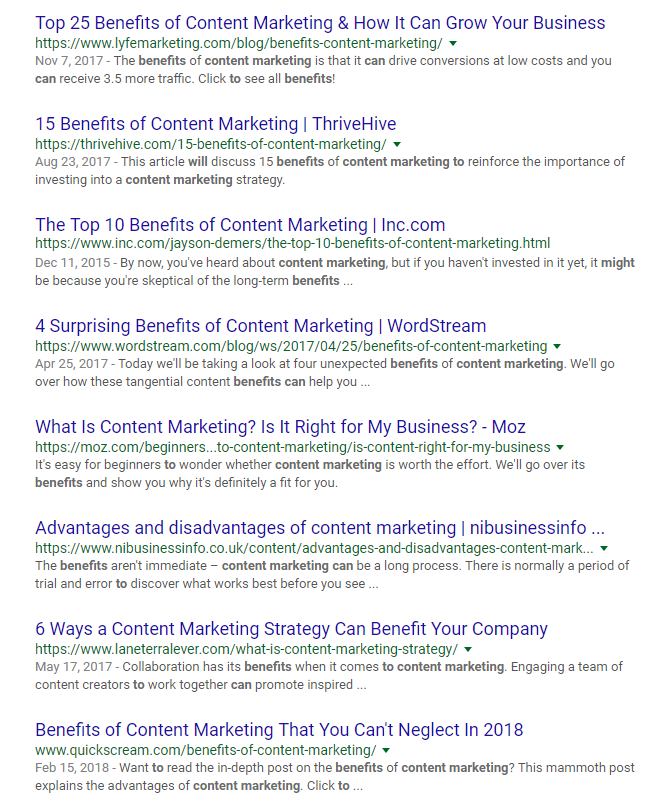
And we’ve got some heavy hitters on the top page that we all strive to emulate: Moz, Inc, ThriveHive, WordStream, and more.
Why does it matter how these services stack up to SERP results?
Because content for the sake of content is useless. Producing great content for our blogs to have nobody read it is always disheartening. If your content can’t compete for the top page results, you won’t get any traffic.
Essentially, you’d be paying for blog posts that nobody will see. Blog posts that won’t result in real, tangible sales for your business. If you are shelling out hard-earned money on original content marketing pieces, they should be top of the line.
Testing each service against current posts in the top search engine results will allow you to judge whether the unique content is good enough to rank, and ultimately, good enough to spend money on.
What is content marketing?
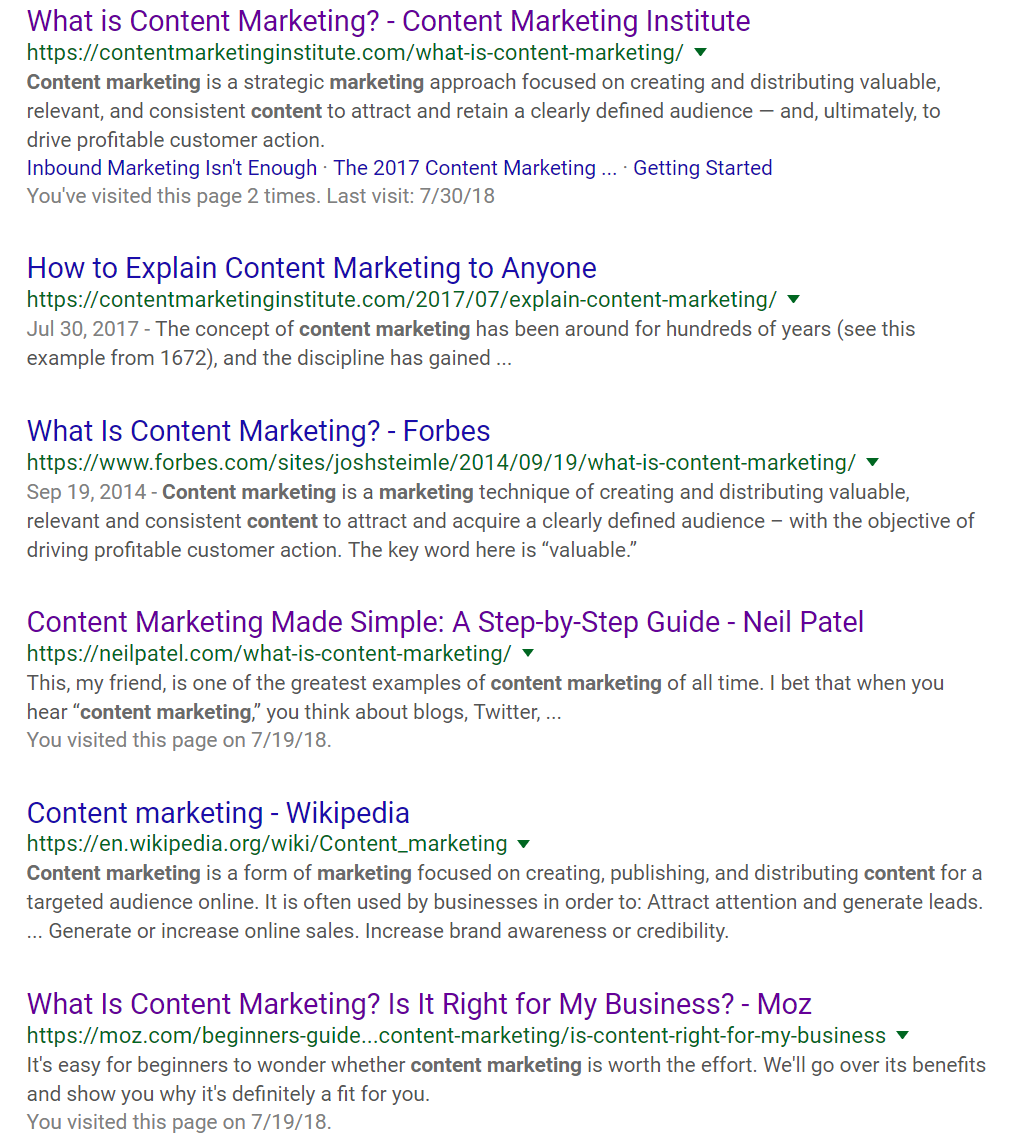
The top content on the SERP for this search term right now has some big hitters:
- Content Marketing Institute
- Forbes
- Neil Patel
- Moz
- Copyblogger
- Marketo
These are some of the biggest names in the marketing industry when it comes to thought leadership.
So, how does content farm content stack up to the current SERPs? Is it worth it?
Specifically, we’ll look at the following three SERP articles from a range of the ranking spectrum:
➁.➁ SERP Comparison #1: Content Marketing Institute
First, you can see some significant strengths in the CMI post, ranking first on the search engine.
Namely, the structure is very easy to follow, and it contains excellent, informative H2 and H3 subheads. Plus, there are many internal and external links.
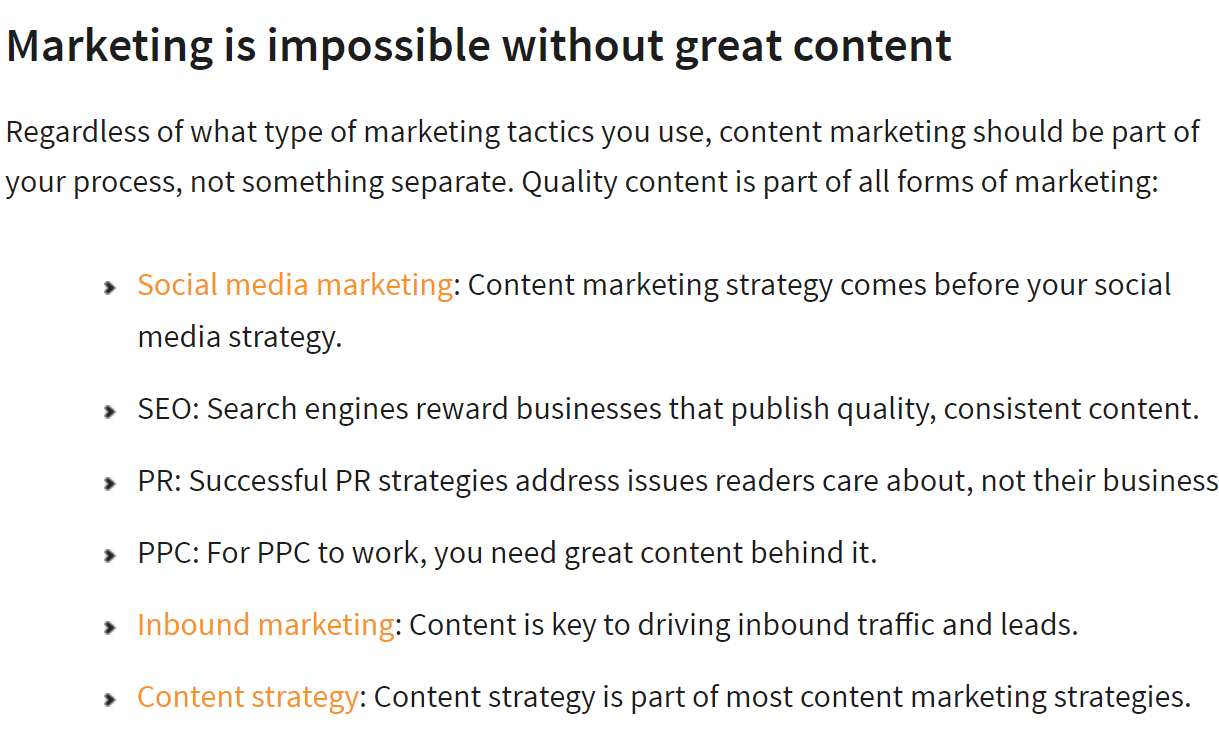
Tapping into both video and infographics, their post has great visuals to accompany their text. These features aren’t commonly available with content farm services.
In terms of actual length, the post isn’t that long, giving hope for this topic. The post length is less than 1,000 words.
While this is just a single topic and other topics are likely to be heavier in length, it shows that word count isn’t the only factor in ranking high.
This provides great promise for a content farm where you can get articles with low word counts fast.
The content in this CMI post is regularly updated and refreshed, something that content farms don’t do.
This is a big plus for CMI, as fresh unique content is key to staying relevant in the SERPs.
➁.➂ SERP Comparison #2: Neil Patel Guide
Neil Patel is widely known in the digital marketing space for producing some seriously long guides.
We’re talking posts with up to 30,000 words total. This one is (only) 15,537 words with a 72 readability score, much higher than anything we received from these content farms.

But in those posts, you can see some quality highlights as to why his original content ranks:
It goes in-depth.
Where content farms fall short, Neil doesn’t.
For instance, the content writing services we tried would merely mention a topic with a few sentences.
Neil breaks down each topic heavily, giving actionable advice to go with it:
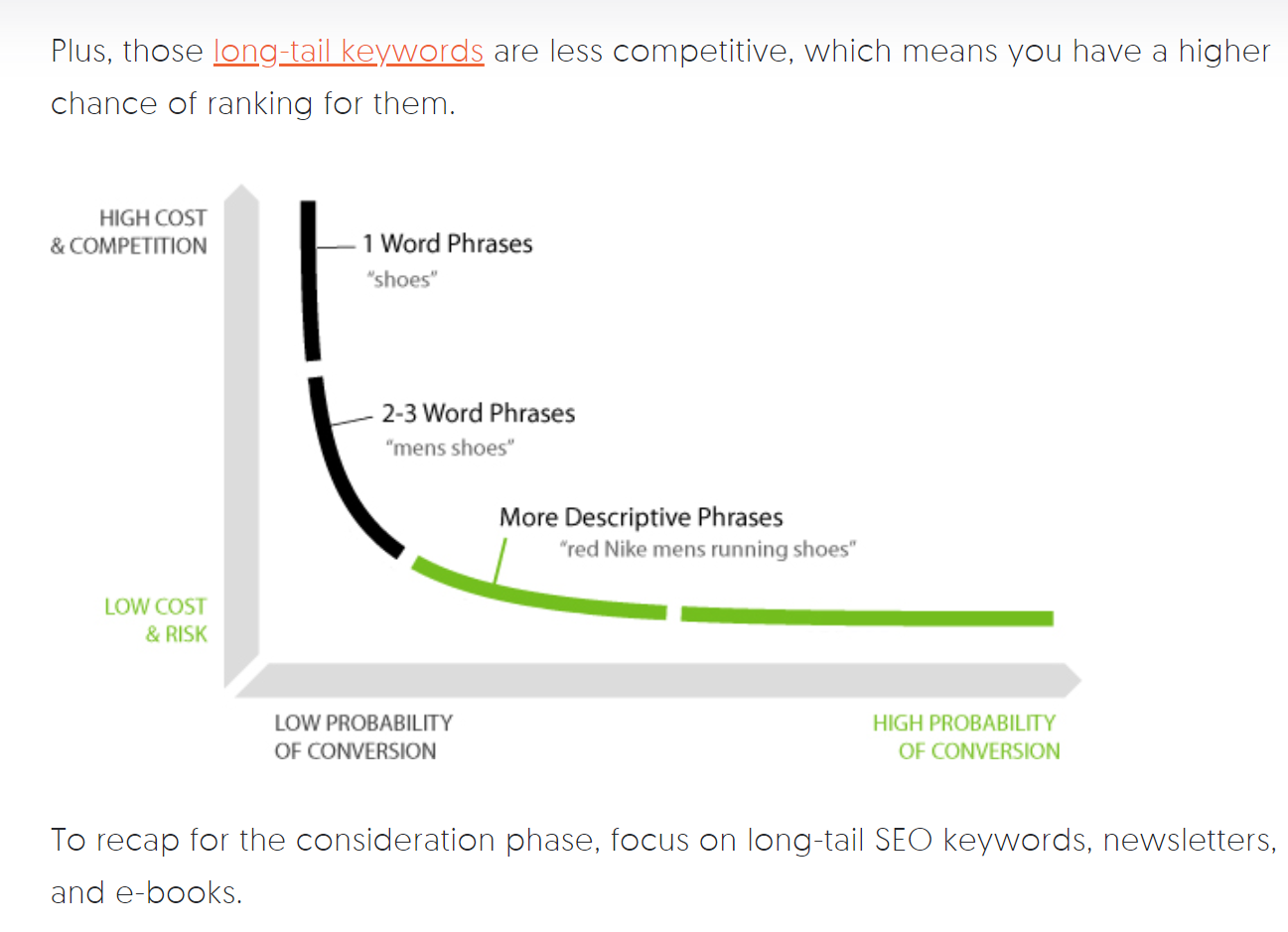
Tons of external links fill his content that signal to Google for authority and topic information.
Plus, internal links are always there pointing traffic to his other related content.
The structure is easy to follow and offers a table of contents at the beginning to accompany it due to the length and depth.
Readability is also much higher than content farm pieces, making this 15,000+ word post seem easy to skim and enjoy.
Overall, it’s hard to imagine any of the content farm pieces outranking his post. It’s simply too in-depth, covering all topics like their own article and using non-stock photos (something that content farms don’t do).
➁.➃ SERP Comparison #3: Moz
Moz. The king of SEO-friendly content online.
It should come as no shock that they’ve produced a huge piece on content marketing that content farms simply can’t live up to.
Their piece on content marketing is a nine-chapter guide covering everything from content marketing’s history to background to strategy and execution.

It’s a master class in search engine optimization when it comes to article writing. The post contains countless internal and external links pointing to relevant sources and their own blog, helping to circulate traffic and build relevance.
The seo-friendly content is freshly updated, and you can bet that accuracy is a significant factor for them.
There were nearly 2,500 words in the first chapter. Assuming all nine have similar amounts, that’s a huge post.
Loaded with visuals and great formatting, it’s hard to see one of these five content farms being able to produce such great content.

On top of custom icons and visuals, real screenshots were a critical factor in the success of this post.

Explaining and showcasing tactics requires more than stock photos, the primary offering of photo purchasing from content farms.
Overall, this Moz post is stacked to the fullest with links, accurate info, screenshots, amazing structure, and more.
When it comes to SERP content for this term, we’ve deemed the following result:
Content farm pieces simply can’t hang.
Even if you purchased a 5,000-word post from one of the five we reviewed, their services still lack critical factors like original images that make these SERP pieces so great.
Here are the objective grading criteria we will use to assess article strength.
➌ Objective Grading Scale: How the 5 Content Writing Services Will Be Assessed

| Section Contents: ➂.➀ How Grading Works ➂.➁ Internal and External Links ➂.➂ Article Structure and Readability ➂.➃ Plagiarism ➂.➄ Content Accuracy ➂.➅ Expert Opinions |
|---|
➂.➀ How Grading Works
Copywriting, blogging, and content, in general, are very subjective. I like Shakespeare, and you like Christopher Marlowe. Your boss loves storytelling, but you prefer short and sweet listicles.
You read a post and you either love it or hate it. You’re either glued to the screen or running for the hills to the next piece of content. But when it comes to content marketing for organic search, there are some objective ways to grade success.
Namely, factors that you commonly see amongst top ranking articles for a given keyword search.
For instance, writing a blog post of 500 words with no internal links, external links, or structure would obviously not rank for a popular keyword. It doesn’t meet the standards of top content for that search.
For grading the articles written at each service, we have developed an objective grading scale based on the latest studies of top content and what ranks for a given search.
On top of that, we will be comparing the content farm articles directly to top SERP posts to see if they undershoot, meet, or exceed quality standards and current competition.
Let’s dive into the factors we will analyze.
➂.➁ ✅ Internal and External Links
Internal links simply point to other relevant pieces of unique content on your site. But more importantly, they help shape site architecture (creating webs of related topics to boost authority).

When writing in your niche, it’s common that topics will overlap. It’s natural, and a gives you a great chance to send traffic from your new post to related website content you have already posted.
Writing original content and having nobody visit it is devastating. Internal links give you a chance to showcase more of that great content to visitors already on your site.
So it’s a win-win for both Google + visitors.
According to Brian Dean of Backlinko, 2-5 internal links per new post is the sweet spot. Rand says, “A lack of internal links can seriously hamper a page’s ability to get crawled + ranked.”
Relevancy is also crucial when adding internal links. It’s tempting to feel like a digital marketing wizard and sprinkle internal links all over the place. To keyword stuff your links and anchor text. Try to shy away from that strategy and instead, focus on 2-5 relevant topics you’ve covered before.
External links are the opposite of internal links: they link out to other websites posting relevant information. You are giving another site a backlink by doing so, but also signaling relevance to Google by referencing authoritative sites.
Plus, you’re increasing credibility in claims by referencing third-party sources that back up your points.
Brian Dean says: “Not linking out might be the #1 on-page SEO mistake that I see people make. I try to use 2-4x outbound links per 1000 words. That’s a good rule of thumb for most sites.”
Why so many links? Because linking out to relevant and high authority web content sends signals to Google that you desperately crave: trust, credibility, and topic authority.
Don’t fall into the trap of linking to link. Not all web content is created equal. Link to relevant studies and publications whenever appropriate.
➂.➂ ✅ Article Structure and Readability
When you’re writing, it’s natural to get into a flow state. Things start to click. You’re sitting in your favorite coffee shop drinking a black coffee (or a unicorn frappuccino, if that’s your thing) and the words just roll off your fingers onto the keys.
Hours go by, and you’ve written thousands of words of prime content filled with stories, facts, and helpful advice to your readers.
What you do next can make or break your article success: structure.
Structure and readability strike a fine line between optimization. Data tells us to optimize for keywords, anchor text, images, etc. But our human brain tells us to just write and let it flow.
Focusing too much on either side can be detrimental to success.
Being too rigid ruins the flow state of both writing and reading, but having no structure leaves readers confused and scrambling to find what they want within a detailed post.
To objectively analyze this, we’ll look at how Grammarly reports on readability:
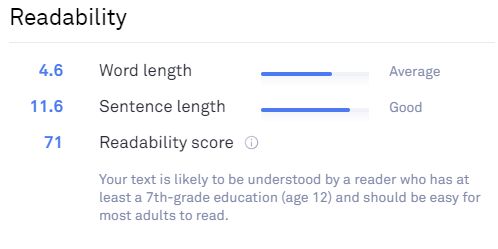
(Grammarly doesn’t cost much, so you can follow these exact steps.)
The higher the readability score, the better.
AutoCrit builds on the readability analysis and provides a few other useful tools to help you figure out how well (or is it good?) the writing looks, too.
In addition, we’ll look at the structure of the article itself:
Do they use H2 headers? H3s or bolding for subsections? Are the heading, intro, and conclusion clearly separated from the body text?
All these factors will play a role in how we score for structure and readability.
➂.➃ ✅ Plagiarism
High school and college teachers across the world are jumping for joy. Yes, plagiarism with online content is a real thing. Whether it’s copying the exact structure of existing articles or lacking citations on borrowed phrases and sections, it’s plagiarism.
And if our teachers would expect anything from us, it would be to avoid it like the plague. Unless of course, you want to get expelled. Ah, the good old days.
Back on track, there are a few ways to objectively check for plagiarism that we will implement here:
- Using our Premium Grammarly account that scans articles and compares them to billions of web pages: this will tell us what percentage of content is copied or used in other places on the web. Perfect for spotting direct text copy and pastes. But what about indirect plagiarism?
- Double-checking against top SERP results for the target keyword. The prompt we test has the main keyword of content marketing, so, chances are, professional content writers will be searching that as a base-point for research. We will be looking into the top results for that term and inspecting factors like article structure, H2 header similarities, etc. These will give us an idea if this is unique content, or if it’s merely recycled and re-written junk.
As you can imagine, any form of direct plagiarism where content is copied and citations are intently left out will result in a serious penalty to the overall score.
➂.➄ ✅ Content Accuracy
This one is pretty self-explanatory.
Essentially, we will be combing each article to see if the content is accurate.
For instance, are they defining tactics correctly? Did they say “XX tactic is good for this” when data proves that it’s not?
Content accuracy is key to success in content marketing.
Users in your niche can quickly tell if you know what you’re talking about or not.
Even if they can’t, they’ll find out the hard way, and it will come back to bite you.
You can’t have a writer talking about buying social media followers as the best way to grow your traffic when that’s clearly not true.
When looking for content accuracy, we will review every statement and see if any are verifiably inaccurate or lacking the proper citing.
Honorable Mentions: Images and Length.
I know what you’re thinking: how has he not covered images or word count yet?
The one issue with covering these two crucial topics in this study is the simple fact that we controlled for word count and images cost extra on these services.
Due to this fact, we can’t knock the sites for not producing 2,000-word posts with 15 images when we didn’t buy them.
➂.➅ ✅ Expert Opinions
Content is subjective at the end of the day. No matter how thorough we try to objectively grade it. (And we’re talkin’ thorough, as you’ll see below.)
So we reached out to a few experts, who all perform content marketing at the highest levels, to ask them a very simple question:
Would you publish this piece on your site (yes or no)? And why or why not?
We told them to ignore word count alone, so that the writer (and blog writing service) wouldn’t be judged solely on that if we didn’t pay for a long enough piece.
Simple, right? Well, wait ’till you see what they have to say for each one.
Conclusion
Are professional content writing services good or bad? Gaetano sums it up nicely:
Gaetano DiNardi, head of demand generation at Nextiva

“Content writing services are mostly garbage quality from my experience – largely because the writing does not come from a truly credible person with hands-on expertise in a given field. Most content shops hire a bunch of outsourced researchers that are stringing together a collection of regurgitated ideas from other existing sites, so nothing is uniquely valuable. I call it, content marketing recycling. There is also a new phenomenon where crappy link building companies are trying to disguise / position themselves as a content marketing service. Some even get as sleazy as listing their prices based on the domain authority of the site they place the article (backlink) on. What’s made Sales Hacker and other companies I’ve worked with the most successful is getting contributors in the field to share their ideas, and shape it together with an editorial expert with strong SEO chops. This is the future of content in my opinion.”
Content is digital marketing.
You literally can’t generate traffic, leads, or sales without it.
And yet, most companies look to save a buck on content creation.
They focus on the cost, instead of the investment.
Having original content made for the sake of filling up your blog isn’t going to work. It doesn’t work. As we’ve shown here.
Terrible content won’t rank. It won’t persuade visitors. And it won’t keep people coming back for more.
All it does is gather digital dust and cobwebs.
There is no ‘middle’ ground, either. You’re better off NOT spending money on content, if you can only ‘afford’ mediocre drivel.
Otherwise, the only way to stand out, get ahead, and start growing your top line is through awesome content. Excellent content, created by excellent craftspeople.
Yes, it’s going to cost you more. But it’s also going to actually create a positive ROI, too.
Unlike all of the content writing services we just reviewed.





